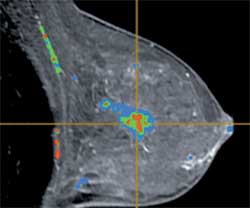 Magnetic resonance imaging (MRI) of the breast continues to show double digit growth in 2008 and is one of the fastest growing procedures in radiology departments, this according to Arlington Medical Resources (AMR), a diagnostic imaging research firm.
Magnetic resonance imaging (MRI) of the breast continues to show double digit growth in 2008 and is one of the fastest growing procedures in radiology departments, this according to Arlington Medical Resources (AMR), a diagnostic imaging research firm.
In the first half of 2008, the total number of patients undergoing MRI of the breast increased 23 percent over the same period last year. MRI of the breast is typically used to diagnose breast cancer.
Beginning in 2007, the American Cancer Society began recommending breast MRI as a screening modality for the 1.4 million American women at high risk for the disease. Breast MRI typically finds smaller tumors earlier than mammography and other modalities. It also can spot increased or abnormal blood flow, a sign of early breast cancer not visible on mammogram.
The ACS does not recommend breast MRI for women with low cancer risk. This is because the very thing that makes MRI attractive – its ability to reveal detail not present in x-rays – leads to more false posititives. MRI doesn’t approach the level of specificity that other modalities do. Specificity, in this case, is the probability that an individual who does not have breast cancer will be correctly identified as healthy; high specificity reduces the need for callbacks and biopsies. Better use of contrast media (approximately 90 percent of patients undergoing an MRI also received a contrast agent, says AMR) improves the delineation between normal and abnormal tissues and increases specificity.
There were 40,060 breast cancer fatalities in 2007. Approximately 80% of breast cancers occur in women over the age of 50; in women over 65 the cancer kills one out of two.